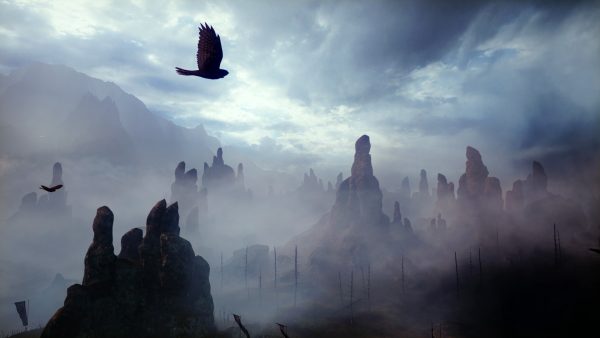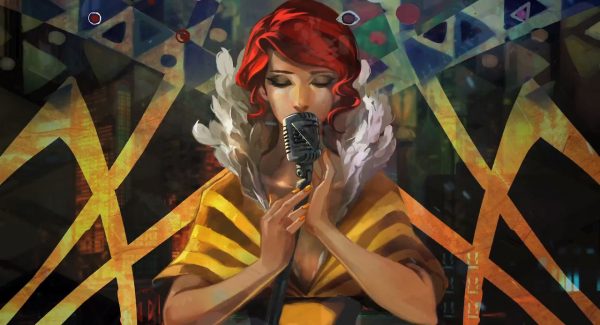
Redbrick Gaming’s finest and most readily available musical connoisseur’s pick, and justify (for extra marks), their favourite video game soundtrack
Dragon Age: Inquisition – Alex Green, Gaming Editor
Whilst there are many AAA titles that have graced us with great soundtracks, typically the RPG has the most scope for their melodies. 100-hour long games need a damn good score to at least make the time sound great. Whilst the Mass Effect and Elder Scrolls franchise all boast some great tracks, there is true beauty in the soundtrack for Dragon Age: Inquisition.
Trevor Morris had worked with EA numerous times on titles such as Army of Two and two Command & Conquer games, but certainly had his work cut out for the third game which was unlike any of his previous experience. What he creates is glorious. The score balances beautiful choral voices with strings to create memorable melodies and leitmotifs that provide a scale of epic adventure to a game bursting with it. Pieces like ‘Journey To Skyhold’, ‘Siege of Adamant’ and of course the main theme are all entrenched in classic fantasy orchestral music but have a distinct flavour with booming brass accompanying them.
“The ace up the sleeve comes in the form of the game’s numerous and excellent tavern songs
That enough would make for a great soundtrack. However, the ace up the sleeve comes in the form of the game’s numerous and excellent tavern songs. This part is made by composer Raney Shockne with USC educator Nick Stoubis providing the guitar and an incredible vocal performance by Elizaveta Khripounova. With Skyhold boasting a tavern, these songs provide some soprano excellence against contained guitar strumming. Within these songs lies lyrics that add to the lore of Dragon Age and the game’s thematic story on faith. ‘Maker’ asks whether the gods have abandoned humanity in the most trying of times. ‘Empress of Fire’ glorifies Empress Celene and her efforts to protect the people of Orlais. ‘Sera’ sings about the titular elf companion. All contrast beautifully and provide a great break from the action.
Beyond all of this, the soundtrack is celebrated within Dragon Age: Inquisition. The game embraces the power of sound at numerous points within. Unlike some games where the music feels like some fun window dressing, Bioware wisely use the talents of the musicians to expertly create moments based entirely around the music. The best is at the end of the first act, as the heroes have left a town, fleeing the enemy and pondering how they go on. At which point, a song entitled ‘The Dawn Will Come’ is heard. It starts as one alto female voice and ends as a cacophony of glorious voices, all singing in hope at what is to come over the next 80 hours of gameplay. This is a game blessed with a fantastic soundtrack and it absolutely knows it.

The Legend of Zelda: Ocarina of Time – Sam Arrowsmith, Gaming Writer
HEY! LISTEN!
This is important. The Legend of Zelda series has been around for over 30 years and, under the watchful eye of master composer Koji Kondo, has produced some of the most memorable soundtracks in gaming history. But everyone knows the true king of the Legend of Zelda games is Ocarina of Time, and it is here that the best soundtrack of them all lies.
The titular instrument actually brings some of the best music in the game, even though the songs themselves rarely last long when played. My personal favourite is one of the Zelda series’ most catchy songs: ‘Saria’s Song’. Travelling through a place called “The Lost Woods” sounds a lot less intimidating when Saria’s cheery piping plays through the trees. It’s been adapted in various forms throughout the entire series, testifying to its popularity. The ‘Song of Storms’ is also an in-universe earworm, with the windmill attendant enraged by a struggle to get it out of his head for seven years. Additionally, the Temple of Time would not be complete without the relaxing chanting of the ‘Song of Time’, a song which can also be played through the Ocarina. All of the Ocarina songs are key from a soundtrack perspective, because not only do they sound great, but they also provide crucial in game functions. For example, ‘Saria’s Song’ charms Darunia into helping you, the ‘Song of Storms’ brings the power of the weather and opens hidden grottoes, whilst the ‘Song of Time’ opens the Gate of Time (as well as moving certain blocks).
“The quality of a final battle can be easily defined by its music…
Beyond the actual instrument, though, the soundtrack has some legendary music. Each dungeon has more stunning music than the last, culminating in the Spirit Temple, whose background music conjures a fittingly mystic air that fits the name and the setting perfectly. The boss music is also especially memorable, with particular note given to the Fire Boss music. It only appears in the battles with King Dodongo and Volvagia, but it really left an impression when I first heard it, and it was considered of sufficient note to be reprised in Twilight Princess. Fight music, of course, brings us to the final battle. The quality of a final battle can be easily defined by its music, particularly in the Zelda series. Whether it’s the single-phase duel with Demise in Skyward Sword, or the four part barrage of Twilight Princess, the music makes the setting. Ocarina of Time definitely does not disappoint. The initial brawl with Ganondorf is suitably dramatic but doesn’t feel like a final battle. That’s when you realise, it isn’t. The Castle collapses, the final challenge reveals itself, and the screen is emblazoned with the word the hardcore Zelda fans had been anticipating the whole game: “GANON”. As you struggle against the beast, an epic soundtrack plays that perfectly captures the image of a life or death struggle against the King of Evil.
The soundtrack of this game captures the spirit of the N64 generation and sums up Nintendo in general. They’ve been in the business longer than Sony and Microsoft combined, and their expertise shows in games like this. This soundtrack is the last one Kondo oversaw on his own, although his trademark style can be seen in Nintendo games to this day. For a generation of gamers, Ocarina of Time was a defining moment, and it set a bar that, in the eyes of critics and fans, only Breath of the Wild can beat. This makes it special, and the soundtrack makes it even more so.

Transistor – Kieren Platt, Gaming Writer
This summer I had the honour of being present at Supergiant Games 10th Anniversary Concert in Seattle, at PAX West 2019. I’d bumped into composer Darren Korb when crossing the road to the venue, queued for three hours so I could have a seat at the front, to watch the very music that got me into listening to music in the first place. I’d first heard Transistor‘s soundtrack five years ago, and 4,800 miles away. And here I was, Darren Korb and Ashley Barrett about ten metres away from me, reinventing those same tracks right before me. It almost spiritual.
But I’m getting ahead of myself. Ask anyone what the main strength of Supergiant’s games are, and a not insignificant-number of them will say the soundtracks. I could write thousands of words on each game, but for the sake of this multi-feature, there really is no contender to Transistor. Nothing comes even close. Every piece is bursting with complexity and sentiment. From the first track, Old Friends, a lonely guitar weeps in pure gain, to Paper Boats, an outpour of bitter-sweet heart as the credits roll, every piece is special in some way. Transistor is composed in its own genre combination, “Old-world Electronic Post-rock”.
“There really is no contender to Transistor. Nothing comes even close
“The ‘Old-world’ portion helps define the location,” Darren emailed me. “I imagine Cloudbank as sort of a sci-fi Venice. It’s an attempt to express some of the texture of the place. The ‘Electronic’ component for me represents the threat of the Process. This manifests itself as chip-distorted drum samples, computer sounds, synths, etc. The ‘Post-rock’ part is meant to express some of our tonal goals. I used spooky delayed out guitars and some driving repetitive riffs to try to convey some of the bleakness of the world, and to amplify the emotional stakes.”
Transistor does a couple of remarkable things, the first being that six tracks feature Ashley Barrett on vocals. Transistor‘s story-telling is emergent, and tells itself the more you put pieces of the puzzle together in your own head; these songs and their lyrics, sung by the protagonist, Red, are an essential part of the game’s narrative and emotional core. Darren writes, “Transistor presented a unique challenge, in that all of the music for the game, I imagined as being music Red herself had made before the events of the game. I did my best to get inside the head of the character and answer the questions ‘What music would Red make?'”
In Circles, for example, is a song about the boss that Red is fighting, while she’s fighting it, dealing with the distant yet directly competitive relationship between the two characters. As the battle continues, and the boss is destroyed, a corrupted version of the track takes over instead. It gets to the heart of why Transistor is fantastic. Hold your TAB key at any point in game, and Red will hum a new motif into the piece that’s playing. A dynamic soundtrack that encourages you to stand still, hum, and reflect.
This is just touching the surface here, of course, but the depth of Transistor‘s music alone makes it one of my favourite games of all time, let alone the rest of what the game has to offer. Korb’s music for all four games is available on bandcamp, as well as on CD and vinyl. I strongly advise against missing out.

Donut County – Sam Nason, Gaming Editor
Imagine the sound of your brain gearing up, sitting down to work, and beginning to have the best writing session of your life. This is Donut County’s first track, ‘Garbage Day’, its speedy but joyful opening building and fluctuating as the sounds of the game’s world nests deep in your ears. Donut County, a small indie title released in August 2018, may be a relatively new game on the block – but it has one of my favourite game soundtracks of all time.
The brunt of it is jolly, uncomplicated music that is perfect for putting on in the background (especially on the bitter winter nights that are only too common nowadays). Its 42 tracks clock in at 1 hour and 41 minutes; from quiet and contemplative electronic bops like ‘999ft Below’ and ‘Pup’s Odyssey’ to more bouncy build-ups with ‘Salt and Pep’ and of course the ‘Quack Anthem’, there’s a track for any occasion. Each piece oozes creativity and is easy to sit back and absorb; the versatility of Daniel Koestner and Ben Esposito’s soundtrack is quite astounding considering its small, independent source, though obviously this is not a bad thing.
The entire premise of Donut County is that you, as BK the raccoon, are controlling your all-enveloping hole from a phone app, and the soundtrack does a wonderful job of articulating this. Some of its music is akin to one of those Youtube playlists one might stick on when they’re studying (to this end, there is even a song named ‘Study Beats’ which sounds eerily similar) and the album certainly wouldn’t be amiss on a mobile phone such as BK’s.
The album is quirky, uncomplicated and merry – the ideal accompaniment to its likewise gameplay. Its inspiring twangs act as a perfect background for the simple but humourous puzzles one embarks on within the title; yet they also act as a great vehicle for tackling real-life ruts or monotony.
‘Nesting’ in particular emerges as one of my favourite tracks. Beginning with gentle and hushed guitar strums, it develops into a relaxed and twinkling motif that speeds up with the player, sampling a yawning whistle-like noise to capture its contradictory sleepy-yet-bouncy tone. ‘Lazy River’ will always have a special place in my heart as it was the first track I ever heard from the game – even prior to its release – and reminds me of a rainy Sunday afternoon, sitting inside, staring out the window with a nice cup of hot chocolate. Peaceful, and safe. Bliss.
The entire album is available on any streaming service you could think of, as well as on vinyl. You’d be doing yourself a real disservice if you let this soundtrack pass you by. Get some work ready to do or have a quiet afternoon outside the cold – Donut County always welcomes new visitors.

Pokemon Emerald Version – Tom Martin, Gaming Editor
From the first bright notes of the introduction, to the baleful bells of the ‘Battle! Rayquaza/Kyogre/Groudon’, Pokémon Emerald’s OST is filled to its 16-bit breaches with emotion, nostalgia and trumpets.
Released in 2005, Pokémon Emerald was the first video game I ever owned. Until then I’d got by watching my Dad play The Great Escape¸ or Medal of Honor: Rising Sun. An integral part of what this game so special to me was the soundtrack, with each precious memory of the game wrapped up in the OST: from picking Torchic as my first starter, to save Professor Birch from a rabid Zigzagoon and surfing all across the region on my Corphish, never questioning the logistics of doing so. It is no exaggeration to say that if you played you played me any track from this game, I could not only tell you what part of the game it’s from, but also what my relationship status was when I played it (single).
We are introduced to the soundtrack with a stunning overture to accompany a similarly stunning cinematic. The piece really captures the essence of the entire OST: beginning with a gentle, twinkling melody reminiscent of the homely tracks of the early game; the next section has an upbeat energy that inspires adventure, preparing you for the journeyman portion of the game where you’ll be travelling up volcanic mountains, through tree-top cities and across and beneath the waves; finally, we get an intense, minor rendition of the instantly recognisable Red/Blue/Yellow theme that’s a warning and really raises the stakes for the game’s story.
Speaking of surfing, however, it is here that we are treated to a particularly fun piece. In the Ruby/Sapphire/Emerald generation, players famously spend a lot of time on the water, making their way between the various Islands to the east of the Hoenn region. Accompanying them? A lovely waltz. A combination of flutes and horns (of course) that ebbs and flows with the virtual tide. It’s a genuinely sweet piece that would sometimes cause me to stop playing, just so I could listen to the track without the harassment of countless Wingull and Tentacool. When you’re surfing to a soundtrack like that, how can you ever have ‘too much water’?
My final choice track is one that sparks a particular awe in me: Rayquaza’s Theme. Phantom of the Opera *wishes* it had what Rayquaza’s Theme has. It’s an iconic piece for an iconic cutscene: as the battle between Groudon and Kyogre, the Gods of the land and the sea, for the fate of the world rages, the black sky bursts with an emerald light to the foreboding minor chords of the most organ-like sound the glorified pocket calculator could muster. From this heavenly portal Rayquaza descends, in all its snake-like glory, cutting short the music with a deafening calm that causes even gods to retreat. It takes a very special piece of music to make me feel the same chill this piece does.
The music in the Pokémon series has always been spectacular, but the Emerald soundtrack will always hold a special place in my heart.
What’s that? You want to check out some more ‘Redbrick Picks’? Or even, maybe, a different form of article altogether? Well, don’t let us stop you…
Redbrick Picks: Breaking the ice
Comments